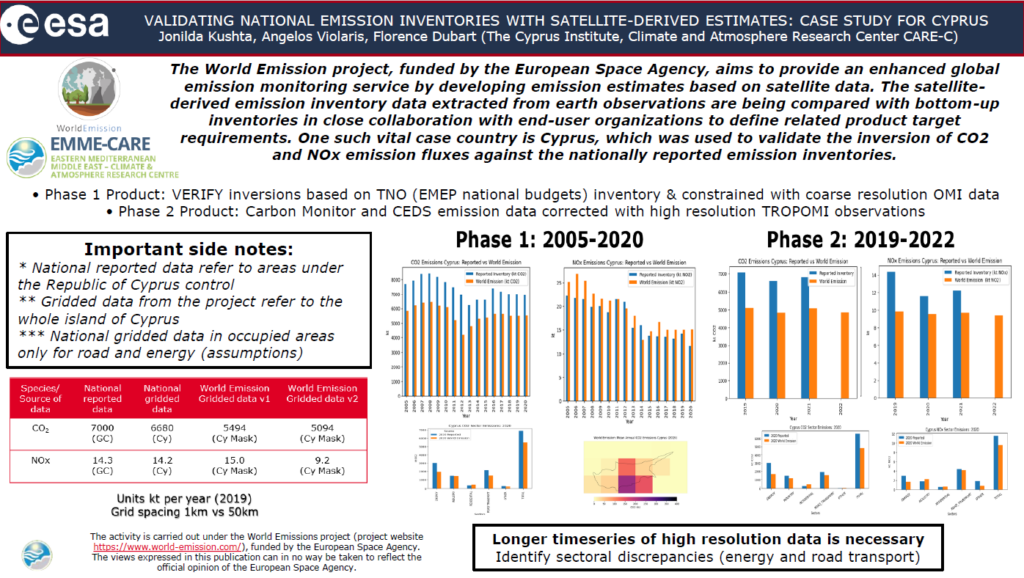The World Emission project at the 3rd Annual Scientific Workshop on Climate and Atmosphere Research & Innovation in the Eastern Mediterranean and Middle East (EMME) region

Latest updates of the World Emission Project, relevant to policy-oriented end users, were presented at the 3rd annual scientific workshop on Climate and Atmosphere Research & Innovation in the Eastern Mediterranean and Middle East (EMME) region, which took place online on 7 November, 2023.
Dr Jonilda Kushta, a research scientist at CARE-C of the Cyprus Institute, who leads the team of the CyI researchers contributing to the World Emission project, delivered a VPICO presentation entitled ‘Validating National Emission Inventories with Satellite- Derived Estimates: Case study for Cyprus’. Dr Kushta presented a few World Emission research components that, within the context of the project, can be beneficial for the validation of the emission fluxes of greenhouse gases and air pollutants. Cyprus was used as a case study in order to validate the inversion of CO2 and NOx emission fluxes against the nationally reported emission inventories.
The workshop was a great success with the participation of more than 340 scientists, researchers, students and industry professionals, in the area of research & innovation on climate change and air pollution, from over 50 countries in the EMME region. Additionally, 22 oral (including 3 keynote speakers) and 34 VPICO presentations were delivered by representatives of universities, research institutions and private companies, actively engaged in the topics of air pollution and research innovations related to climate change.
You can find more about the workshop here.

We present an updated (v2) catalog of NOx emissions from point sources as derived from TROPOspheric Monitoring Instrument (TROPOMI) measurements of NO2 (Products Algorithm Laboratory (PAL) product) combined with wind fields from ERA5. Compared to version 1 of the catalog (Beirle et al., 2021), several improvements have been introduced to the algorithm. Most importantly, several corrections are applied, accounting for the effects of plume height on satellite sensitivity, 3D topographic effects, and the chemical loss of NOx, resulting in considerably higher and more accurate NOx emissions. In addition, error estimates are provided for each point source, taking into account the uncertainties of the individual retrieval steps.
The v2 catalog is based on a fully automated iterative detection algorithm of point sources worldwide. It lists 1139 locations that have been found to be significant NOx sources. The majority of these locations match power plants listed in the Global Power Plant Database (GPPD). Other NOx point sources correspond to cement plants, metal smelters, industrial areas, or medium-sized cities.
The emissions listed in v2 of the catalog show good agreement (within 20 % on average) to emissions reported by the German Environment Agency (Umweltbundesamt, UBA) as well as the United States Environmental Protection Agency (EPA). The data are publicly available at https://doi.org/10.26050/WDCC/No_xPointEmissionsV2 (Beirle et al., 2023).
Open-access of the published paper on Earth Science Data journal on https://essd.copernicus.org/articles/15/3051/2023/
World Emission passed to Phase 2 for the full service implementation!
Clean air is of vital importance for our health and for the environment. Greenhouse gases emissions are also one of the factors responsible for climate change. GMV is proud of the work that its team is contributing to the World Emission project, which is focused on improving emission inventories by using measurements collected by satellites.
This project began in 2022, and it is divided into two phases, each lasting for one year. The first phase has now been completed, and one of the team’s most recent accomplishments has been obtaining the European Space Agency’s approval for initiation of the second phase.
GMV is the leader of the World Emission project, and it is also acting as its technology integrator. The GMV team is overseeing the general technical coordination of seven organizations: LSCE, KAYRROS, Capgemini, MPIC, ULB, BSC, and CYI. In addition, GMV is responsible for designing the validation plan, which is a key aspect for comparing the satellite data with measurements taken from Earth. For the full project, GMV is also in charge of the communications work package, stakeholder participation, and user requirements. This includes organizing international workshops focused on encouraging the use of what is known top-down emission inventories, by using satellite measurements to complement the traditional bottom-up approach.
Currently, World Emission is working with different atmospheric gases at a variety of scales: from localized sources to regional and worldwide production at an unprecedented scale. All of these data sets are being integrated into a single online portal. This is being made freely available to the public, as a way of encouraging the use of emission inventory information analyzed based on satellite data.
One of the first challenges the consortium had to confront was the need to organize an international workshop just seven weeks after the project began. Another challenge for the consortium was the difficult work of creating the World Emission portal within a period of only nine months. The team is also now deeply involved in the work required to implement the complete service and validate the final products.
It is expected that the final version of the online portal will be ready in December 2023, and the workshop for the project’s stakeholders will take place during the first months of 2024. You won’t want to miss it!

